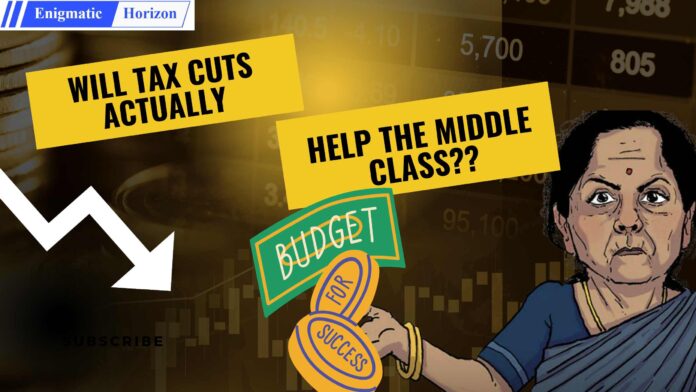The recent Union Budget 2025, presented by Finance Minister Nirmala Sitharaman, introduced significant tax cuts for the middle class. Many netizens can be seen happy and even celebrating. But is it really something to be so happy about? The government has framed these reforms as a major relief measure, and so the reality is that they come after years of economic distress, rising inflation, and stagnating wages. The new tax slabs, which increase the exemption limit and lower tax rates for various income brackets, have been introduced at a time when the cost of living has surged. And needless to say, this puts immense financial pressure on Indian households.
Therefore, it would not be wrong to say that these tax cuts should not be seen as a “gift” from the government but rather as a necessary response to the public frustration we have seen in the last few years.
Over the past few years, citizens have struggled with skyrocketing prices of essential commodities, high fuel costs, and increasing taxation through GST. Thus, we can say that it is public pressure, declining consumer spending, and the apparent sluggish economic growth which made the government eventually implement these reforms. The question remains: Are these tax cuts sufficient to truly ease the burden on the middle class, or do they merely serve as damage control ahead of the upcoming Delhi elections?
A Response to Public Pressure, Not Generosity
For years, India’s middle class has faced the brunt of economic instability, facing problems such as rising fuel prices, increased cost of essential goods, and high taxation. The high Goods and Services Tax (GST) rates, coupled with inflation, had left little room for financial flexibility. Additionally, salaries and wages for many professionals had not kept pace with the cost of living, making it difficult for households to manage expenses. Three decades ago, one could purchase a vehicle and even their own home, on the salary of a single person. However, now even in families where both the husband and the wife are salaried individuals, can be seen struggling to afford the same!
Therefore, we can argue that government’s move to reduce taxes is not an act of generosity but a necessary step to address the economic distress faced by millions. And with the rise of goods and services, which are going to get only higher in the upcoming years, this tax cut is far from a “gift” for the middle class. In addition, protests, declining consumer spending, and sluggish economic growth has created an environment where tax cuts has become inevitable. Had the government not acted now, it risked further economic slowdown and mounting frustration from the public.
The Impact of the Tax Cuts
The new tax slabs aim to ease the burden on middle-class taxpayers. The tax exemption limit has been raised, and new, lower tax rates have been introduced for various income brackets. These measures are expected to increase disposable income, allowing people to save more or spend on essential goods and services.
However, the real question remains: Are these tax cuts enough to make a significant difference? On paper, the reforms provide relief, but in practice, will they even be sufficient to offset the years of economic strain?
Inflation and Cost of Living Remain a Challenge
One of the major concerns surrounding the tax cuts is that they do not directly address the rising cost of living. While taxpayers may have more money in hand, the benefits will not be tangible due to the extreme high prices of essential commodities, fuel, housing, and education. Will these savings from lower taxes be enough to compensate for years of increased expenses? Without additional measures to control inflation, these reforms might only serve as temporary relief rather than a long-term solution.
Government Revenue and Public Services
Another crucial aspect to consider is how these tax cuts will impact government revenue and public services. With lower tax collection, the government might also reduce spending in other areas, which in return, can affect infrastructure development, healthcare, and education. If “revenue shortages” arise, the government might again increase indirect taxes or reduce subsidies, effectively shifting the financial burden to citizens in another form.
A Step in the Right Direction, But More is Needed
While the new tax reforms are indeed a welcome step for middle-class Indians, they are not a complete solution. The government needs to shift its focus on reducing inflation, ensuring stable fuel prices, and improving employment opportunities. Sustainable economic policies that promote growth without overburdening citizens are essential for long-term financial stability.
Moreover, a fair taxation system should not just focus on giving temporary relief but should aim to create a balanced structure where the burden is distributed equitably. The middle class has long been the backbone of India’s economy, and their financial well-being directly influences the country’s overall economic health. If the government, therefore, genuinely wants the welfare of the common middle-class man, it needs to take additional steps to ensure that the middle class actually benefits in the long run, rather than just giving them something to pacify them for the moment.
